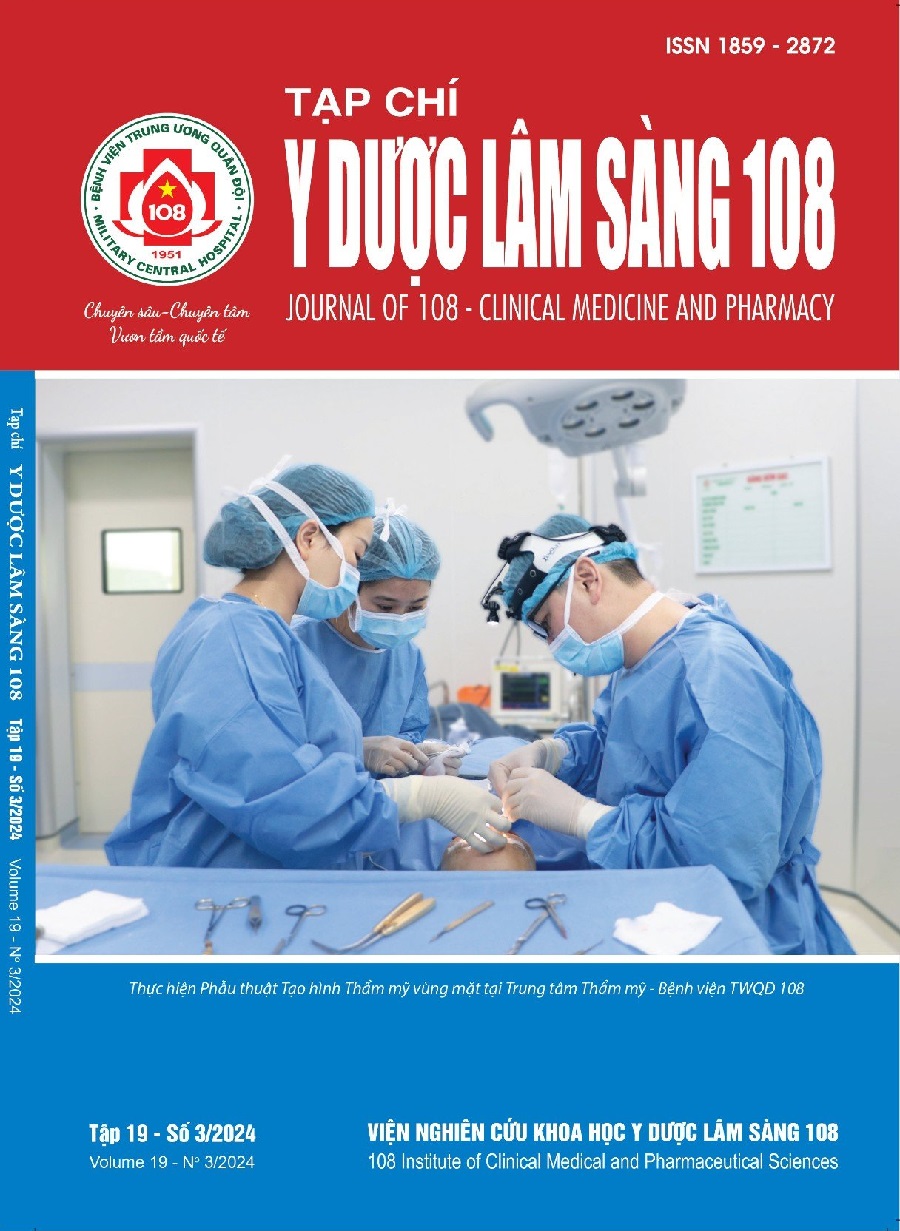Nutritional status at admission and some related factors in COVID-19 patients at 108 Military Central Hospital
Main Article Content
Keywords
Abstract
Objective: Survey nutritional status and understanding some related factors among COVID-19 patients at 108 Military Central Hospital. Subject and method: A cross-sectional descriptive study was conducted on 103 COVID-19 patients from January 2023 to June 2023. Result: In a total of 103 patients, the average age was 70.6 ± 16.7. When evaluated using the SGA tool, it was found that: SGA-A (no malnutrition) accounted for 70.9%; SGA-B (mild and moderate malnutrition) accounted for 23.3%; SGA-C (severe malnutrition) accounted for 5.8%. The rate of having mechanical ventilation was 23.3%. The death rate during treatment was 18.4%. Diagnosis of anemia accounted for 14.6%, hypoalbuminemia accounted for 33.0%. Conclusion: Malnutrition among COVID-19 patients accounts for a high rate. There is a relationship between age, mechanical ventilation, anemia and malnutrition status according to SGA of the study subjects. All hospitalized COVID-19 patients need to be screened and assessed for nutritional status to guide treatment and minimize the risk of complications and death in patients.
Article Details
References
2. Arkin N, Krishnan K, Chang MG et al (2020) Nutrition in critically ill patients with COVID-19: Challenges and special considerations. Clin Nutr Edinb Scot 39(7): 2327-2328.
3. Cunha Ana IL (2019) Frailty as a predictor of adverse outcomes in hospitalized older adults: A systematic review and meta-analysis. Ageing research reviews 56 (2019): 100960.
4. Detsky AS, McLaughlin JR, Baker JP et al (1987) What is subjective global assessment of nutritional status?. JPEN J Parenter Enteral Nutr 11(1): 8-13.
5. Manish J, Tak ML, Gupta R et al (2022) Relationship of anemia with COVID-19 deaths: A retrospective cross-sectional study. J Anaesthesiol Clin Pharmacol 38(1): 115-119.
6. Lakenman PL (2021) Energy expenditure and feeding practices and tolerance during the acute and late phase of critically ill COVID-19 patients. Clinical nutrition ESPEN 43(6): 383-389.
7. Nicolau J, Ayala L, Sanchís P et al (2021) Influence of nutritional status on clinical outcomes among hospitalized patients with COVID-19. Clin Nutr ESPEN 43: 223-229.
8. Narayan SK, Gudivada KK, Krishna B (2020) Assessment of nutritional status in the critically Ill. Indian J Crit Care Med 24(4): 152-156.
9. Peña JE, Pacheco RA, Ascencio IJ et al (2020). Hypertension, diabetes and obesity, major risk factors for death in patients with COVID-19 in Mexico. Arch. Med Res 52(4): 443–449.
10. Singer P, Blaser AR, Berger MM et al (2019) ESPEN guideline on clinical nutrition in the intensive care unit. Clinical nutrition 38(1): 48-79.
11. Tosato M, Calvani R, Ciciarello F et al (2023) Malnutrition in COVID-19 survivors: prevalence and risk factors. Aging Clin Exp Res 35: 2257-2265.
12. Wang Yan (2021) Invasive mechanical ventilation and nutrition intake in association with serious outcomes among COVID-19 ICU patients. University of Washington.
13. WHO (2023) COVID-19 in Viet Nam situation report 72. Accessed January 01, 2023.
14. WHO Expert Consultation (2004) Appropriate body-mass index for Asian populations and its implications for policy and intervention strategies. The Lancet 363(9403): 157-163.
15. WHO (2011) Haemoglobin concentrations for the diagnosis of anaemia and assessment of severity. Vitamin and Mineral Nutrition Information System. (WHO/NMH/NHD/MNM/11.1) Geneva: WHO; Accessed August 3.
16. Zhou Fei (2020) Clinical course and risk factors for mortality of adult inpatients with COVID-19 in Wuhan, China: A retrospective cohort study. The Lancet: 1054-1062.
 ISSN: 1859 - 2872
ISSN: 1859 - 2872
